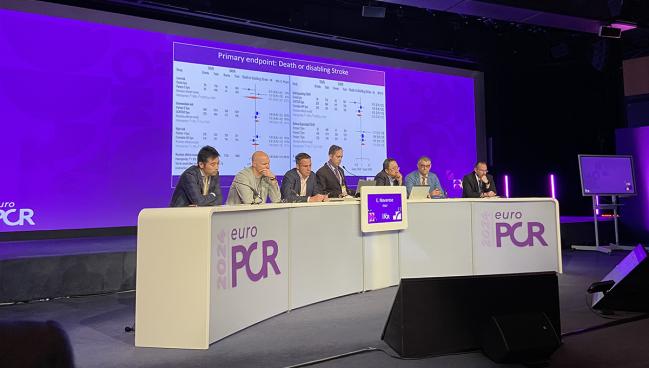TAVI, Surgery Look Similar Long-term Across Risk Spectrum: Meta-analysis
Researchers saw some differences between valve types; while provocative, these data need confirmation, observers say.

PARIS, France—A meta-analysis of landmark clinical trials comparing TAVI against surgical aortic valve replacement across the surgical-risk spectrum of patients with severe aortic stenosis showed there was no difference in the risk of death or disabling stroke between the two procedures over longer-term follow-up.
There did appear to be a difference between surgery and TAVI based on valve type, however, with investigators reporting a higher risk of death/disabling stroke with balloon-expandable valves versus surgery—but not with self-expanding valves. Additionally, while investigators saw a similar risk of valve thrombosis between the surgical and percutaneous interventions, again that risk was higher with TAVI when operators used a balloon-expandable valve.
“These findings, as we expected, support the comparable long-term safety and efficacy of TAVR in comparison to SAVR,” senior investigator Eliano Navarese, MD, PhD (University of Sassari, Italy), who presented the results this week at EuroPCR 2024, said during a press conference announcing the results. “But based on this large-scale analysis, this is one of the first studies showing some [longer-term] differences between TAVR devices.”
Nicholas van Mieghem, MD, PhD (Erasmus Medical Center, Rotterdam, the Netherlands), who moderated the session where the results were presented, urged caution interpreting the results, noting that all meta-analyses are inherently limited.
“It's obviously not a randomized control trial,” he said. “This is a combination of multiple studies, and there is always an issue with cross comparisons because if we just look at the surgical arms, the outcomes with surgery in the balloon-expandable studies were different from the outcomes with surgery in the self-expanding trials.”
For example, the primary endpoint of death or disabling stroke at 24 months with surgery in the Evolut Low Risk trial was 6.7%. In PARTNER 3, the 1-year risk of death or disabling stroke, which was one of the study’s secondary endpoints, was 2.9%. In the most recent long-term follow-up of these low-risk trials at 4 and 5 years, event rates differed in the surgical arms, too, a finding that suggests the two trials didn’t enroll completely identical patients.
“There should always be a word of caution when we’re comparing one [study] with the other,” said Van Mieghem.
Interactions by Valve Type
The meta-analysis, which was published simultaneously in JSCAI, included the PARTNER and Evolut series of trials testing balloon-expandable (Sapien/Sapien 3; Edwards Lifesciences) and self-expanding (CoreValve/Evolut; Medtronic) transcatheter valves versus surgery in 7,785 patients at low, intermediate, and high risk for surgery. Overall, patients were followed for a weighted mean of 5.76 years.
Regarding the primary endpoint of death or disabling stroke, there was no significant difference between TAVI and SAVR (HR 1.02; 95% CI 0.93-1.11), and these results were consistent across the spectrum of baseline risk. Stratified by valve type, however, there appeared to be a numerically lower risk of death/disabling stroke with TAVI using the self-expanding valve compared with surgery (HR 0.92; 95% CI 0.80-1.07), while the trend went in the other direction with a balloon-expandable valve (HR 1.10; 0.99-1.22).
Although the test for interaction by valve type was not statistically significant (P = 0.06), Navarese said that one of the strengths of including large-scale clinical trials in a meta-analysis is that it reduces the risk of false-negative errors.
For mortality, there was no difference in risk between TAVI and surgery, and these results were consistent across the risk spectrum and in the stratified analysis by valve type.
With respect to valve thrombosis, there was no significant difference in risk between valve surgery and TAVI, but the risk of valve thrombosis trended lower with the self-expanding valve than with the balloon-expandable valve. The rates of valve thrombosis were 0.42% for the self-expandable valve and 1.1% for the balloon-expandable valves in the comparisons against surgery, which had a rate of 0.23% (P = 0.06 for interaction by valve type).
Not surprisingly, TAVI was associated with a significantly higher risk of permanent pacemaker implantation compared with surgery. There was a significant interaction by valve type, with the balloon-expandable valve faring better than the self-expanding device (P < 0.01 for interaction). Here, there was a near threefold higher risk of the need for permanent pacemaker with the self-expanding valve versus surgery (HR 2.83; 95% CI 2.27-3.54), but just a trend toward a slightly higher risk with balloon-expandable valves (HR 1.19; 95% CI 0.98-1.44).
Data Supported by Imaging
Asked if he thinks there is a difference between valve types, or if he thinks one valve is better than the other, Navarese told TCTMD it’s possible.
“There are nuances related to the flow dynamics, the implantation, and the stagnation of flow, which could potentially explain the differences between the valves,” said Navarese. “What struck me was the consistency between the valve thrombosis and the primary endpoint, the direction of a reduction with one valve versus the other.”
Additionally, Navarese said they conducted an analysis of imaging features that includes hypoattenuated leaflet thickening and reduced leaflet motion stratified by percutaneous valve type, and these results were consistent with the valve thrombosis findings favoring the self-expanding valves.
“It’s convergent, and it should prompt us to at least reflect on which potential patient might be a better candidate for one or the other valve,” said Navarese.
For van Mieghem, though, these new data need to be confirmed in a head-to-head randomized trial before any firm conclusions can be made.
Similarly, Christopher Meduri, MD (Karolinska Institute, Stockholm, Sweden), who moderated the session, called the presentation “thought-provoking” and, like van Mieghem, argued for head-to-head comparisons of different devices “in order to provide the best outcomes for our patients.”
Navarese agreed, adding that any such study would need to be sufficiently powered to assess major clinical outcomes in an appropriate patient population, such as younger patients who will be living longer with these valves.
Michael O’Riordan is the Managing Editor for TCTMD. He completed his undergraduate degrees at Queen’s University in Kingston, ON, and…
Read Full BioSources
Talanas G, Laconi A, Kereiakes DJ, et al. Long-term outcomes of transcatheter vs surgical aortic valve replacement: meta-analysis of randomized trials. JSCAI 2024;Epub ahead of print.
Disclosures
- Navarese reports grants/research support from Abbott.
- Meduri reports consulting for Alleviant and Boston Scientific. He is the chief medical officer of Anteris Technologies (non-employed position), founder of V2V, and serves on the advisory board of X-Dot.
- van Mieghen reports grant/research support for Abbott, AstraZeneca, Biotronik, Boston Scientific, CSI, Daiichi Sankyo, Edwards Lifescies, Medtronic, Pie Medical Imaging, PulseCath BV, and Shockwave. He reports honoraria and/or consulting fees from 415 Capital Management Gmbh, Abbott, Abiomed, ACIST Medical Systems, Amgen, Anteris, Approxima Srl, Biotronik, Bolt Medical, Boston Scientific, CSI, Daiichi Sankyo, Inc, JenaValve, Luma Vision, Materialise, Medtronic, OpSens Medical, Pie Medical Imaging, Siemens Healthineers, Spring Healthcare, and Teleflex.






Comments